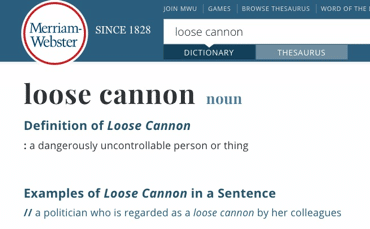In today’s business world, off-the-cuff comments or behaviors by key players can expose your organization to millions of dollars in lost reputation, sales, legal fees, and other recovery costs. How, then, do you determine if you have a loose cannon on your hands and what are the steps required to prevent their actions from harming your bottom line?
Is There a Loose Cannon on Your Deck?
By Jonathan Bernstein & Anthony Moore

Loose cannon referred to an actual weapon before it entered the language as a metaphor. In the days before ships were equipped with fixed-turret guns, muzzle-loading cannons were mounted on wheels and rolled back and forth between gunports. A gun not properly secured could break loose either from the force of recoil or from the jostling of the vessel in choppy waters, presenting a hazard to sailors. (Merriam Webster)
One of the questions we ask any client during a vulnerability audit is:
Are there any loose cannons associated with your organization, people who – even if they are strong supporters – tend to say the wrong things to the wrong people at the wrong time, causing damage?”
The answer, within most organizations, is “yes.” But then the question is:
“How are you identifying and mitigating potential loose cannons?
“It is important to realize that the identification of ‘loose cannons’ is critical, as their unstructured and off-the-cuff comment or behavior can expose the organization to millions of dollars in legal fees and negative actions that are incalculable,” said organizational management expert Anthony Moore, principal & CEO of Paradigm Group Consultants.
“Most often in organizations an inadvertent comment or unintended action can create a flurry of internal and sometimes external issues that are almost impossible to resolve,” said Moore. “Comments that are degrading to employees based on race, gender, ethnicity and other diversity background traits are made every day in the workplace, without regard to who is in the room. The ‘loose cannon’ often assumes that the comment, or email or Tweet is ‘harmless’ or ‘no one will care’ before it creates a fire-storm that is hard to put out.”
Crisis managers and HR pros need to work together to prevent, or at least mitigate, future damage. The first step is the development and communication of organizational messages, i.e., Mission Statements, Core Values and Codes of Conduct that clearly identify which behaviors are preferred within the organization and which ones are not appreciated. Encourage everyone to practice restraint in all written communication, in particular. Management and human resources policies must also support the organization’s beliefs and practices related to fair treatment and equality. The clear articulation of these behavioral messages and policies should ensure potential loose cannons are compliant and supportive of the organization’s culture. Further, organizational leadership must “walk their talk” in terms of behavior if their codes and policies are to be respected.
We also see a best practice in the utilization of the performance feedback process, in setting goals related to individual actions and performance. The appraisal and feedback communication should be a manager’s key tool to ensure that an employee understands the critical importance of their comments and actions and how they may put the organization at risk. On-going observation and feedback will normally ensure that these actions /comments are dealt with before they become toxic.
At the same time, the organizations crisis management team should have contingency plans and messages in place in the event a loose cannon really makes the stuff hit the fan. While executive leadership considers not merely the quality of an employee’s work, but the risk of any specific employee causing real damage to the organization, however inadvertently.
Secure those loose cannons, folks, before someone gets hurt!
###
[Anthony Moore, is the Principal and CEO of Paradigm Group Consultants, an Organizational Development, Diversity and Inclusion and Crisis Management Consultancy. The firm’s clients cover a full range of Fortune 1000, Higher Education and many Non Profit organizations. Their crisis management interventions include a wide array of very high profile situations and even more that were not public, however just as critical. He is part of the Bernstein Crisis Management network of expert contractors.] [Jonathan Bernstein is president of Bernstein Crisis Management, Inc. and author of Manager’s Guide to Crisis Management.]
